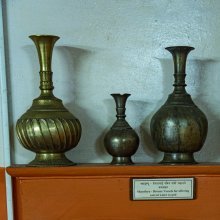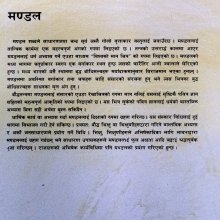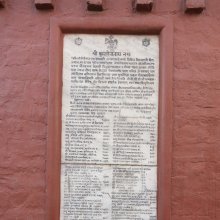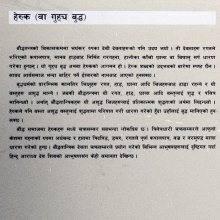Pavitra, Pavitrā: 28 definitions
Introduction:
Pavitra means something in Buddhism, Pali, Hinduism, Sanskrit, Jainism, Prakrit, the history of ancient India, Marathi, Hindi, biology. If you want to know the exact meaning, history, etymology or English translation of this term then check out the descriptions on this page. Add your comment or reference to a book if you want to contribute to this summary article.
Images (photo gallery)
In Hinduism
Ayurveda (science of life)
Dietetics and Culinary Art (such as household cooking)
Source: Shodhganga: Dietetics and culinary art in ancient and medieval IndiaPavitra (पवित्र) refers to “pure” and represents a particular dietetic effect according to the 17th century Bhojanakutūhala (dravyaguṇāguṇa-kathana), and is commonly found in literature dealing with the topics of dietetics and culinary art, also known as Pākaśāstra or Pākakalā.—Accordingly, the dietetic effect pavitra is associated with the following conditions: Food utensils made of Crystal (sphaṭika-pātra) and Vaiḍūrya.
Unclassified Ayurveda definitions
Source: Wisdom Library: Āyurveda and botany1) Pavitrā (पवित्रा) is another name for Tulasī, which is a Sanskrit word referring to Ocimum tenuiflorum (holy basil), from the Lamiaceae family. It is classified as a medicinal plant in the system of Āyurveda (science of Indian medicine) and is used throughout literature such as the Suśrutasaṃhita and the Carakasaṃhitā. The synonym was identified in the Rājanighaṇṭu (verses 10.148-149), which is a 13th century medicinal thesaurus.
2) Pavitra (पवित्र) is another name (synonym) for Tila, which is a Sanskrit name for the plant Sesamum indicum (sesame). This synonym was identified by Narahari in his 13th-century Rājanighaṇṭu (verses 16.111-116), which is an Ayurvedic medicinal thesaurus. Certain plant parts of Tila are eaten as a vegetable (śāka), and it is therefore part of the Śākavarga group of medicinal plants, referring to the “group of vegetables/pot-herbs”.

Āyurveda (आयुर्वेद, ayurveda) is a branch of Indian science dealing with medicine, herbalism, taxology, anatomy, surgery, alchemy and related topics. Traditional practice of Āyurveda in ancient India dates back to at least the first millenium BC. Literature is commonly written in Sanskrit using various poetic metres.
Purana and Itihasa (epic history)
Source: archive.org: Shiva Purana - English Translation1) Pavitra (पवित्र) refers to one who is “holy”, and is used by Satī to describe Śiva, according to the Śivapurāṇa 2.2.29. Accordingly as Brahmā narrated to Nārada:—“[...] Then inciting the fury of Dakṣa further, she said to Viṣṇu and all other devas and sages unhesitatingly.. Satī said:—‘[...] It is surprising that you are so wicked as to harbour ill feelings against Śiva who is the lord of all, whose dictum is untransgressable and who is the holiest of the holy (pavitra). You are certainly enemy of Śiva’”
2) Pavitra (पवित्र) refers to “pure”, according to the Śivapurāṇa 2.2.43.—Accordingly, as Brahmā narrated to Nārada:—“[...] thus I have described the fascinating story of Satī (i.e., satīcaritra) to you which confers worldly pleasures and salvation, which is divine and bestows all wishes. This narrative is flawless, pure (i.e., pavitra), sanctifying, conferring heavenly pleasures, glory, longevity and the pleasure of sons and grandsons”.
Source: Cologne Digital Sanskrit Dictionaries: The Purana Index1a) Pavitra (पवित्र).—Gods of the epoch of 14th Manu.*
- * Bhāgavata-purāṇa VIII. 13. 34; Viṣṇu-purāṇa III. 2. 43.
1b) (paritras)—one of the five devagaṇas of the 14th Bhauta Manu: are the seven worlds.*
- * Brahmāṇḍa-purāṇa IV. 1. 106, 198. Vāyu-purāṇa 100. 111-2.
2a) Pavitrā (पवित्रा).—A river in Kuśadvīpa.*
- * Brahmāṇḍa-purāṇa II. 19. 62. Matsya-purāṇa 122. 72.
2b) A main stream of Kuśadvīpa.*
- * Viṣṇu-purāṇa I. 4. 43.
Pavitrā (पवित्रा) refers to the name of a River mentioned in the Mahābhārata (cf. VI.10.20). Note: The Mahābhārata (mentioning Pavitrā) is a Sanskrit epic poem consisting of 100,000 ślokas (metrical verses) and is over 2000 years old.

The Purana (पुराण, purāṇas) refers to Sanskrit literature preserving ancient India’s vast cultural history, including historical legends, religious ceremonies, various arts and sciences. The eighteen mahapuranas total over 400,000 shlokas (metrical couplets) and date to at least several centuries BCE.
Vaishnavism (Vaishava dharma)
Source: Devotees Vaishnavas: Śrī Garga SaṃhitāPavitrā (पवित्रा) refers to the eighteenth of twenty-six ekādaśīs according to the Garga-saṃhitā 4.8.9. Accordingly, “to attain Lord Kṛṣṇa’s mercy you should follow the vow of fasting on ekādaśī. In that way You will make Lord Kṛṣṇa into your submissive servant. Of this there is no doubt”. A person who chants the names of these twenty-six ekādaśīs (e.g., Pavitrā) attains the result of following ekādaśī for one year.

Vaishnava (वैष्णव, vaiṣṇava) or vaishnavism (vaiṣṇavism) represents a tradition of Hinduism worshipping Vishnu as the supreme Lord. Similar to the Shaktism and Shaivism traditions, Vaishnavism also developed as an individual movement, famous for its exposition of the dashavatara (‘ten avatars of Vishnu’).
Shaivism (Shaiva philosophy)
Source: Shodhganga: Temple management in the ĀgamasPavitra (पवित्र) refers to a certain ceremony to be performed during pūjā (ritualistic worship), according to the Arcanāvidhipaṭala of Kāmikāgama.—[After Ṣoḍaṣa-Upacāra], the Ācārya then meditates on the Lord and places the holy pavitra on the crown of the liṅga in order to complete the pūjā. The Āgama declares that pavitra is that which protects the worshipper from falling (into hell) due to daily errors of thought, word and deed.
Source: Brill: Śaivism and the Tantric TraditionsPavitra (पवित्र) refers to “purifying” (substance) [?], according to verse 45.201-202 of the Brahmayāmala-tantra (or Picumata), an early 7th century Śaiva text consisting of twelve-thousand verses.—Accordingly, “The Sādhaka should make [her] sit down there. He should start kissing and embracing her and stimulating her. He should collect the purifying (pavitra—samārabhya pavitraṃ gṛhya) [substance, i.e. the sexual fluids]. Overjoyed, they should consume [the fluids]...”.

Shaiva (शैव, śaiva) or Shaivism (śaivism) represents a tradition of Hinduism worshiping Shiva as the supreme being. Closely related to Shaktism, Shaiva literature includes a range of scriptures, including Tantras, while the root of this tradition may be traced back to the ancient Vedas.
Kavya (poetry)
Source: archive.org: Naisadhacarita of SriharsaPavitra (पवित्र) refers to 1) a “pair of Kuśa blades used at sarifices for purifying and sprinkling clarified butter”, and is mentioned in the Naiṣadha-carita 17.188.—Nārāyaṇa quotes Kātyāyana. 2) The word may here mean also “a cloth for straining Soma juice”. It is used in this sense in Vedic texts, e.g. Taittirīya-saṃhitā 1.8.21. Sāyaṇa quotes Taittirīya-brāhmaṇa 1.8.5.

Kavya (काव्य, kavya) refers to Sanskrit poetry, a popular ancient Indian tradition of literature. There have been many Sanskrit poets over the ages, hailing from ancient India and beyond. This topic includes mahakavya, or ‘epic poetry’ and natya, or ‘dramatic poetry’.
Yoga (school of philosophy)
Source: ORA: Amanaska (king of all yogas): A Critical Edition and Annotated Translation by Jason BirchPavitra (पवित्र) refers to a “clean place”, according to the Amanaska Yoga treatise dealing with meditation, absorption, yogic powers and liberation.—Accordingly, as Īśvara says to Vāmadeva: “[...] In an isolated, solitary, clean (pavitra) and very beautiful place, [the Yogin] sits comfortably on a level seat and is supported a little from behind. His whole body is placed comfortably and he [remains] very steady and very still. Having fixed his gaze [on an empty space] the measure of a straight arm’s length [in front], he should practice [thus]. [...]”.

Yoga is originally considered a branch of Hindu philosophy (astika), but both ancient and modern Yoga combine the physical, mental and spiritual. Yoga teaches various physical techniques also known as āsanas (postures), used for various purposes (eg., meditation, contemplation, relaxation).
In Buddhism
Tibetan Buddhism (Vajrayana or tantric Buddhism)
Source: OSU Press: Cakrasamvara SamadhiPavitra (पवित्र) refers to “holy grass”, according to the purification (śodhana) of the Pañcagavya (five cow products) ritual often performed in combination with the Cakrasaṃvara Samādhi, which refers to the primary pūjā and sādhanā practice of Newah Mahāyāna-Vajrayāna Buddhists in Nepal.—Accordingly, “[...] Oṃ purified with conch-water Hūṃ. [Give water to patrons.] Cow urine, cow dung, milk, curd, ghee, holy grass, (and) water, The forementioned Pañcagavya and holy grass (pavitra) purifies the body. Oṃ purified with conch-water Hūṃ. [Give water again]”.

Tibetan Buddhism includes schools such as Nyingma, Kadampa, Kagyu and Gelug. Their primary canon of literature is divided in two broad categories: The Kangyur, which consists of Buddha’s words, and the Tengyur, which includes commentaries from various sources. Esotericism and tantra techniques (vajrayāna) are collected indepently.
In Jainism
General definition (in Jainism)
Source: archive.org: Een Kritische Studie Van Svayambhūdeva’s PaümacariuPavitra (पवित्र) participated in the war between Rāma and Rāvaṇa, on the side of the latter, as mentioned in Svayambhūdeva’s Paumacariu (Padmacarita, Paumacariya or Rāmāyaṇapurāṇa) chapter 57ff. Svayambhū or Svayambhūdeva (8th or 9th century) was a Jain householder who probably lived in Karnataka. His work recounts the popular Rāma story as known from the older work Rāmāyaṇa (written by Vālmīki). Various chapters [mentioning Pavitra] are dedicated to the humongous battle whose armies (known as akṣauhiṇīs) consisted of millions of soldiers, horses and elephants, etc.

Jainism is an Indian religion of Dharma whose doctrine revolves around harmlessness (ahimsa) towards every living being. The two major branches (Digambara and Svetambara) of Jainism stimulate self-control (or, shramana, ‘self-reliance’) and spiritual development through a path of peace for the soul to progess to the ultimate goal.
India history and geography
Source: Cologne Digital Sanskrit Dictionaries: Indian Epigraphical GlossaryPavitra.—(EI 9), the argha vessel. (Ind. Ant., Vol. IX, p. 187), thread, 360 of which are tied round the neck of the image of Kṛṣṇa on Śrāvaṇa su-di 12. Cf. Caitra-pavitra. Note: pavitra is defined in the “Indian epigraphical glossary” as it can be found on ancient inscriptions commonly written in Sanskrit, Prakrit or Dravidian languages.

The history of India traces the identification of countries, villages, towns and other regions of India, as well as mythology, zoology, royal dynasties, rulers, tribes, local festivities and traditions and regional languages. Ancient India enjoyed religious freedom and encourages the path of Dharma, a concept common to Buddhism, Hinduism, and Jainism.
Biology (plants and animals)
Source: Google Books: CRC World Dictionary (Regional names)1) Pavitra in India is the name of a plant defined with Desmostachya bipinnata in various botanical sources. This page contains potential references in Ayurveda, modern medicine, and other folk traditions or local practices It has the synonym Coelachyrum longiglume Napper (among others).
2) Pavitra is also identified with Prosopis cineraria It has the synonym Adenanthera aculeata (Roxb.) W. Hunter (etc.).
3) Pavitra is also identified with Sesbania grandiflora It has the synonym Coronilla coccinea (L.f.) Willd. (etc.).
Example references for further research on medicinal uses or toxicity (see latin names for full list):
· Cell Chromosome Res. (1992)
· Lexicon Generum Phanerogamarum (1903)
· Prodromus Florae Peninsulae Indiae Orientalis (1834)
· Fl. Pres. Madras (1919)
· Flora (1855)
· Australian Journal of Botany (1997)
If you are looking for specific details regarding Pavitra, for example extract dosage, side effects, chemical composition, diet and recipes, pregnancy safety, health benefits, have a look at these references.

This sections includes definitions from the five kingdoms of living things: Animals, Plants, Fungi, Protists and Monera. It will include both the official binomial nomenclature (scientific names usually in Latin) as well as regional spellings and variants.
Languages of India and abroad
Marathi-English dictionary
Source: DDSA: The Molesworth Marathi and English Dictionarypavitra (पवित्र).—a (S) Pure, clean, free from ceremonial defilement. 2 Sinless or holy, clean morally. 3 Hallowed or holy--a thing, place, act.
--- OR ---
pavitra (पवित्र).—n (S) The Brahmanical string. 2 also pavitraka n S A ring of darbha (Poa cynosuroides) or of gold, worn on the forefinger at worship and certain rites.
--- OR ---
pavitrā (पवित्रा).—m In wrestling. The attitude of readiness, with the right leg advanced. v kara.
Source: DDSA: The Aryabhusan school dictionary, Marathi-Englishpavitra (पवित्र).—a Pure, clean. Sinless, holy- Hallowed.
--- OR ---
pavitrā (पवित्रा).—m In wrestling. The attitude of readiness, with the right leg advanced. v kara.
Marathi is an Indo-European language having over 70 million native speakers people in (predominantly) Maharashtra India. Marathi, like many other Indo-Aryan languages, evolved from early forms of Prakrit, which itself is a subset of Sanskrit, one of the most ancient languages of the world.
Sanskrit dictionary
Source: DDSA: The practical Sanskrit-English dictionaryPavitra (पवित्र).—a. [pū-karaṇe itra]
1) Sacred, holy, sinless, sanctified (persons or things); त्रीणि श्राद्धे पवित्राणि दौहित्रः कुतपस्तिलाः (trīṇi śrāddhe pavitrāṇi dauhitraḥ kutapastilāḥ) Manusmṛti 3.235; पवित्रो नरः, पवित्रं स्थानम् (pavitro naraḥ, pavitraṃ sthānam) &c.
2) Purified by the performance of ceremonial acts (such as sacrifices &c.).
4) Purifying, removing sin.
-tram 1 An instrument for cleansing or purifying, such as a sieve or strainer &c.
2) Two blades of Kuśa grass used at sacrifices in purifying and sprinkling ghee; N.17.188.
3) A ring of Kuśa grass worn on the fourth finger on certain religious occasions; धौताङ्घ्रिपाणिराचम्य सपवित्र उदङ्मुखः (dhautāṅghripāṇirācamya sapavitra udaṅmukhaḥ) Bhāgavata 6.8.4.
4) The sacred thread worn by members of the first three castes of the Hindus.
5) Copper.
6) Rain.
7) Water.
8) Rubbing, cleansing.
9) A vessel in which the arghya is presented.
1) Clarified butter.
11) Honey.
12) A purifying prayer.
13) A means of purifying the mind.
14) A cloth for straining Soma juice; वायुः पूतः पवित्रेण प्रत्यङ् सोमोऽतिद्रुतः (vāyuḥ pūtaḥ pavitreṇa pratyaṅ somo'tidrutaḥ) Ts.1. 8.21.
-trā 1 The holy basil.
2) Turmeric (pavitrīkṛ 'to purify, sanctify'; pavitrībhū 'to become pure or holy').
Source: Cologne Digital Sanskrit Dictionaries: Shabda-Sagara Sanskrit-English DictionaryPavitra (पवित्र).—mfn.
(-traḥ-trā-traṃ) 1. Pure, clean, purified physically or morally. 2. Who or what cleans, or purifies, &c. n.
(-traṃ) 1. Sacrifical grass, (Poa cynosuroides.) 2. Copper. 3. Water. 4. Rain. 5. Rubbing, cleansing. 6. The vessel in which an Argha or libation or oblation is presented. 7. The Brahminical cord. 8. Ghee. 9. Honey. 10. A couple of Kusa leaves a span long, used at sacrifices to present offerings upon, or to sprinkle Ghee, &c. 11. Kusa grass used to clean or purify Ghee used in a sacrifice. 12. A ring of Kusa grass worn on the fourth finger on some occasions. 13. A text or Mantra of the Vedas. 14. Any divinity, as Agni, &c. f.
(-trā) 1. Holy basil, (Ocymum sanctum.) 2. The name of a river, a little to the north-west of Haridwar; the Pabar. 3. The twelfth of the light fortnight of Sravana, a festival in honour of Vishnu. E. pū to purify, aff. karaṇe itra.
Source: Cologne Digital Sanskrit Dictionaries: Benfey Sanskrit-English DictionaryPavitra (पवित्र).—i. e. pū + tra, I. n. 1. A means of purifying, [Mānavadharmaśāstra] 11, 85. 2. Sacrificial grass, [Mānavadharmaśāstra] 2, 75. 3. Prayer, [Mānavadharmaśāstra] 11, 225. Ii. m. pl. The name of a class of deities. Iii. f. trā, The name of a river. Iv. adj., f. trā. 1. Purifying, [Rāmāyaṇa] 1, 1, 94. 2. Pure, [Mānavadharmaśāstra] 3, 235.
Source: Cologne Digital Sanskrit Dictionaries: Cappeller Sanskrit-English DictionaryPavitra (पवित्र).—[neuter] instrument for cleansing, [especially] filter, strainer, etc.; i.[grammar] anything cleansing or purifying (l.&[feminine]); [adjective] purifying, pure, holy, sinless. [masculine] a cert. sacrifice.
Source: Cologne Digital Sanskrit Dictionaries: Monier-Williams Sanskrit-English Dictionary1) Pavitra (पवित्र):—[from pava] n. a means of purification, filter, strainer, straining-cloth etc. (made of thread or hair or straw, for clarifying fruits, [especially] the Soma), [Ṛg-veda] etc. etc.
2) [v.s. ...] Kuśa grass ([especially] two K° leaves for holding offerings or for sprinkling and purifying ghee etc.), [Śatapatha-brāhmaṇa; Kātyāyana-śrauta-sūtra; Manu-smṛti] etc. (ifc. also ko See sa-pavitraka), a ring of K° grass worn on the fourth finger on [particular] occasions, [Horace H. Wilson]
3) [v.s. ...] a purifying prayer or Mantra, [Manu-smṛti; Yājñavalkya; Mahābhārata]
4) [v.s. ...] a means of purifying or clearing the mind, [Ṛg-veda iii, 26, 8; 31, 6 etc.]
5) [v.s. ...] melted butter, [cf. Lexicographers, esp. such as amarasiṃha, halāyudha, hemacandra, etc.]
6) [v.s. ...] honey, [cf. Lexicographers, esp. such as amarasiṃha, halāyudha, hemacandra, etc.]
7) [v.s. ...] water, [cf. Lexicographers, esp. such as amarasiṃha, halāyudha, hemacandra, etc.]
8) [v.s. ...] rain or rubbing (varṣaṇa or gharṣaṇa), [cf. Lexicographers, esp. such as amarasiṃha, halāyudha, hemacandra, etc.]
9) [v.s. ...] copper, [cf. Lexicographers, esp. such as amarasiṃha, halāyudha, hemacandra, etc.]
10) [v.s. ...] the vessel in which the Argha is presented, [cf. Lexicographers, esp. such as amarasiṃha, halāyudha, hemacandra, etc.] (ifc. -ka, [Mārkaṇḍeya-purāṇa])
11) [v.s. ...] the Brāhmanical cord (cf. trāropaṇs)
12) [v.s. ...] Name of Viṣṇu (also p° pavintrāṇām), [Mahābhārata] (cf, [Religious Thought and Life in India 106])
13) [v.s. ...] of Śiva, [ib.]
14) [v.s. ...] (with ādityānām and devānām) Name of Sāmans, [Ārṣeya-brāhmaṇa]
15) [v.s. ...] a kind of metre, [Colebrooke]
16) [v.s. ...] m. Name of a [particular] Soma-sacrifice belonging to the Rājasūya, [Tāṇḍya-brāhmaṇa [Scholiast or Commentator]; ???]
17) [v.s. ...] Sesamum Indicum, [cf. Lexicographers, esp. such as amarasiṃha, halāyudha, hemacandra, etc.]
18) [v.s. ...] Nageia Putranjiva, [cf. Lexicographers, esp. such as amarasiṃha, halāyudha, hemacandra, etc.]
19) [v.s. ...] Name of a man [gana] aśvādi
20) [v.s. ...] of an Āṅgirasa (the supposed author of [Ṛg-veda ix, 67; 73; 83; 107]), [Ṛgveda-anukramaṇikā]
21) [v.s. ...] ([plural]) Name of a class of deities in the 14th Manv-antara, Pur
22) Pavitrā (पवित्रा):—[from pavitra > pava] f. Name of sub voce plants (basil, saffron, the small Pippala tree etc.), [cf. Lexicographers, esp. such as amarasiṃha, halāyudha, hemacandra, etc.]
23) [v.s. ...] of sub voce rivers, [Mahābhārata; Purāṇa]
24) [v.s. ...] the 12th day of the light half of Śravaṇa (a festival in honour of Viṣṇu), [Horace H. Wilson]
25) Pavitra (पवित्र):—[from pava] mf(ā)n. purifying, averting evil, pure, holy, sacred, sinless, beneficent, [Manu-smṛti; Mahābhārata etc.]
26) Pāvitra (पावित्र):—[from pāva] n. a kind of metre, [Colebrooke] ([wrong reading] for pav?).
Source: Cologne Digital Sanskrit Dictionaries: Yates Sanskrit-English DictionaryPavitra (पवित्र):—[(traḥ-trā-traṃ) a.] Holy, pure, sanctifying. n. Sacrificial grass; cleansing. f. Holy basil; a festival.
Source: DDSA: Paia-sadda-mahannavo; a comprehensive Prakrit Hindi dictionary (S)Pavitra (पवित्र) in the Sanskrit language is related to the Prakrit word: Pavitta.
[Sanskrit to German]
Sanskrit, also spelled संस्कृतम् (saṃskṛtam), is an ancient language of India commonly seen as the grandmother of the Indo-European language family (even English!). Closely allied with Prakrit and Pali, Sanskrit is more exhaustive in both grammar and terms and has the most extensive collection of literature in the world, greatly surpassing its sister-languages Greek and Latin.
Hindi dictionary
Source: DDSA: A practical Hindi-English dictionaryPavitra (पवित्र):—(a) holy, sacred; pure; ~[tā] holiness, sanctity, purity; —[karanā, cara ādi ko] (said out of reverence) to impart sanctity (by paying a visit), to come (e.g. [āja mere ghara ko pavitra kījie]).
...
Kannada-English dictionary
Source: Alar: Kannada-English corpusPavitra (ಪವಿತ್ರ):—
1) [adjective] religiously, spiritually perfect or pure; sacred; saintly; holy.
2) [adjective] having or characterised by, moral virtue; righteous; virtuous; sinless.
--- OR ---
Pavitra (ಪವಿತ್ರ):—
1) [noun] that which is used to make religiously or spiritually pure.
2) [noun] the quality or state of being religiously or spiritually perfect or pure.
3) [noun] that by which religious merit is earned.
4) [noun] the grass Desmostachya tripinnata of Poaceae family, considered as sacred one, used for religious purposes.
5) [noun] a kind of ring made with this grass blade, used to wear on the ring-finger of the right-hand, while performing certain religious rites.
6) [noun] the ring-finger of the right hand.
7) [noun] a kind of ornament for the ears.
8) [noun] the sacrificial thread, worn on the left shoulder passing under the right arm, by men of certain castes; sacred-thread.
Kannada is a Dravidian language (as opposed to the Indo-European language family) mainly spoken in the southwestern region of India.
See also (Relevant definitions)
Starts with (+16): Pavitradarbha, Pavitradesha, Pavitradhanya, Pavitradhara, Pavitragiri, Pavitraka, Pavitrakama, Pavitrakirti, Pavitramguli, Pavitrapani, Pavitrapathana, Pavitrapati, Pavitraputa, Pavitraratha, Pavitrarogapariharaprayoga, Pavitrarohana, Pavitraropana, Pavitraropanaprayashcitta, Pavitraropanaputradaikadashi, Pavitraropanavidhana.
Ends with (+7): Angirasapavitra, Antahpavitra, Apavitra, Ardrapavitra, Atipavitra, Bahitpavitra, Bhupavitra, Brahmapavitra, Caitra-pavitra, Darbhapavitra, Dashapavitra, Jala-pavitra, Kimpavitra, Kshapavitra, Kushapavitra, Mahapavitra, Rashmipavitra, Sadashapavitra, Samapavitra, Sapavitra.
Full-text (+107): Pavitta, Pavitraropana, Pavitrarohana, Pavitrata, Pavitraka, Pavitrapati, Bahitpavitra, Pavitrayana, Apavitra, Antahpavitra, Pavitrin, Pavitradhanya, Pavitratva, Jala-pavitra, Pavitrapani, Brahmapavitra, Mahapavitra, Yajnadravya, Pavitravati, Pavitradhara.
Relevant text
Search found 62 books and stories containing Pavitra, Pavitrā, Pāvitra; (plurals include: Pavitras, Pavitrās, Pāvitras). You can also click to the full overview containing English textual excerpts. Below are direct links for the most relevant articles:
Rig Veda (translation and commentary) (by H. H. Wilson)
Sahitya-kaumudi by Baladeva Vidyabhushana (by Gaurapada Dāsa)
Text 7.123 < [Chapter 7 - Literary Faults]
Taittiriya Upanishad Bhashya Vartika (by R. Balasubramanian)
Verse 1.154-155 < [Book 1 - Śīkṣāvallī]
Garga Samhita (English) (by Danavir Goswami)
Verse 4.8.16 < [Chapter 8 - In the Story of the Yajña-sītās, the Glories of Ekādaśī]
Verse 4.1.4 < [Chapter 1 - The Story of the Personified Vedas]
Verse 1.15.20 < [Chapter 15 - Revelation of the Universal Form to Nanda’s Wife]
Manusmriti with the Commentary of Medhatithi (by Ganganatha Jha)
Verse 3.256 < [Section XVI - Essentials of Śrāddha]
Verse 11.85 < [Section VII - Special Expiation for Special Offences: (a) For Killing a Brāhmaṇa]
Verse 3.279 < [Section XXII - Time for Śrāddha]
Shrimad Bhagavad-gita (by Narayana Gosvami)
Verses 10.12-13 < [Chapter 10 - Vibhūti-yoga (appreciating the opulences of the Supreme Lord)]
Verse 4.38 < [Chapter 4 - Jñāna-Yoga (Yoga through Transcendental Knowledge)]
Verses 9.16-19 < [Chapter 9 - Rāja-guhya-yoga (Yoga through the most Confidential Knowledge)]
Related products





